Assessment for Learning in Modern Foreign Language Teaching
VerifiedAdded on 2023/04/22
|10
|2871
|127
Report
AI Summary
This report delves into the concept of assessment for learning (AFL) within the context of modern foreign language (MFL) classrooms. It defines AFL, explores various types such as diagnostic, formative, and summative assessments, and identifies key AFL strategies including inductive teaching, questioning, and task-based learning. The report emphasizes the crucial role of teachers as facilitators in student-centered MFL classrooms, highlighting the importance of adapting lesson plans and providing opportunities for language practice. It also provides recommendations for implementing AFL effectively, such as involving students in the assessment process, setting clear learning objectives, providing constant feedback, and establishing realistic targets. The report concludes by summarizing the importance of AFL in enhancing language learning outcomes and offering practical guidance for educators.
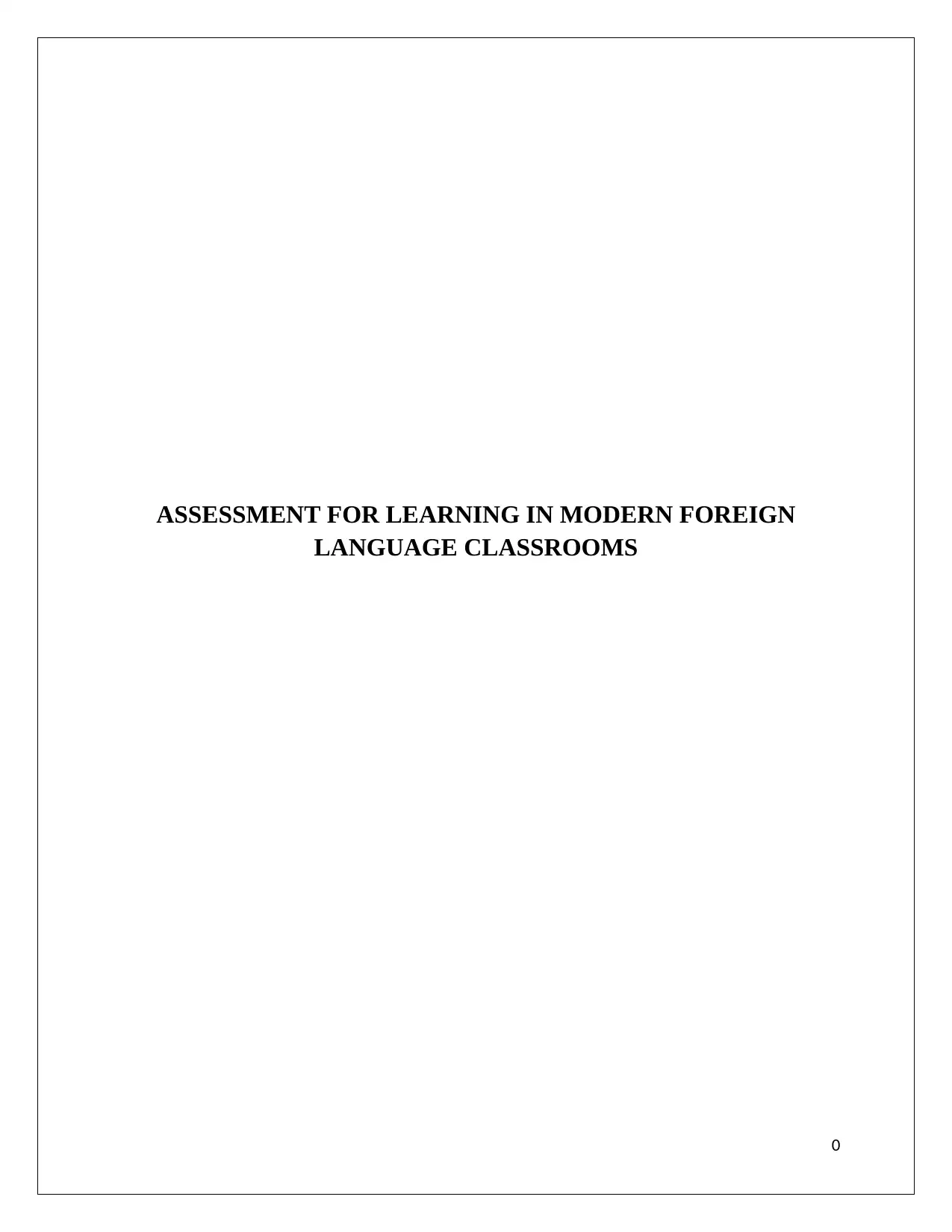
ASSESSMENT FOR LEARNING IN MODERN FOREIGN
LANGUAGE CLASSROOMS
0
LANGUAGE CLASSROOMS
0
Paraphrase This Document
Need a fresh take? Get an instant paraphrase of this document with our AI Paraphraser
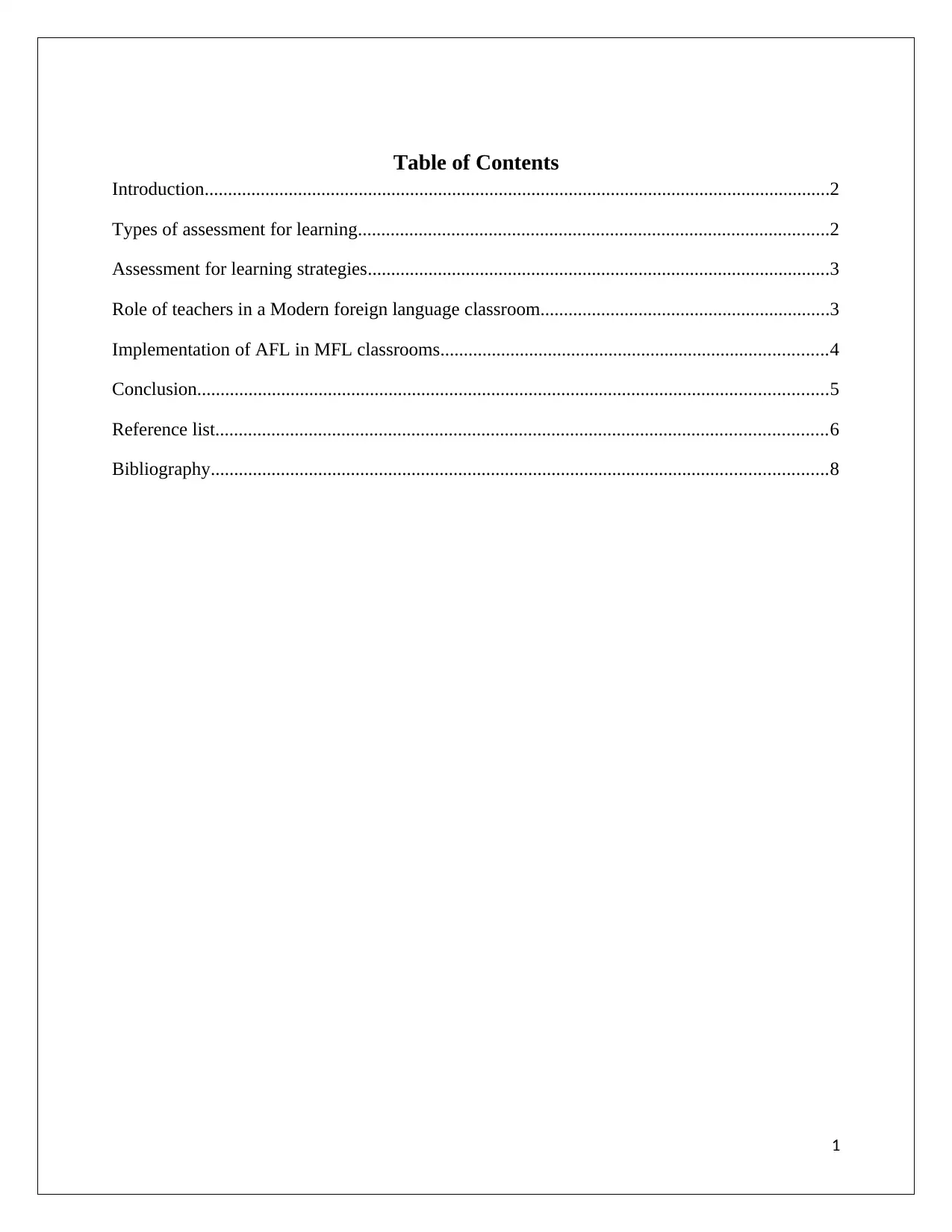
Table of Contents
Introduction......................................................................................................................................2
Types of assessment for learning.....................................................................................................2
Assessment for learning strategies...................................................................................................3
Role of teachers in a Modern foreign language classroom..............................................................3
Implementation of AFL in MFL classrooms...................................................................................4
Conclusion.......................................................................................................................................5
Reference list...................................................................................................................................6
Bibliography....................................................................................................................................8
1
Introduction......................................................................................................................................2
Types of assessment for learning.....................................................................................................2
Assessment for learning strategies...................................................................................................3
Role of teachers in a Modern foreign language classroom..............................................................3
Implementation of AFL in MFL classrooms...................................................................................4
Conclusion.......................................................................................................................................5
Reference list...................................................................................................................................6
Bibliography....................................................................................................................................8
1
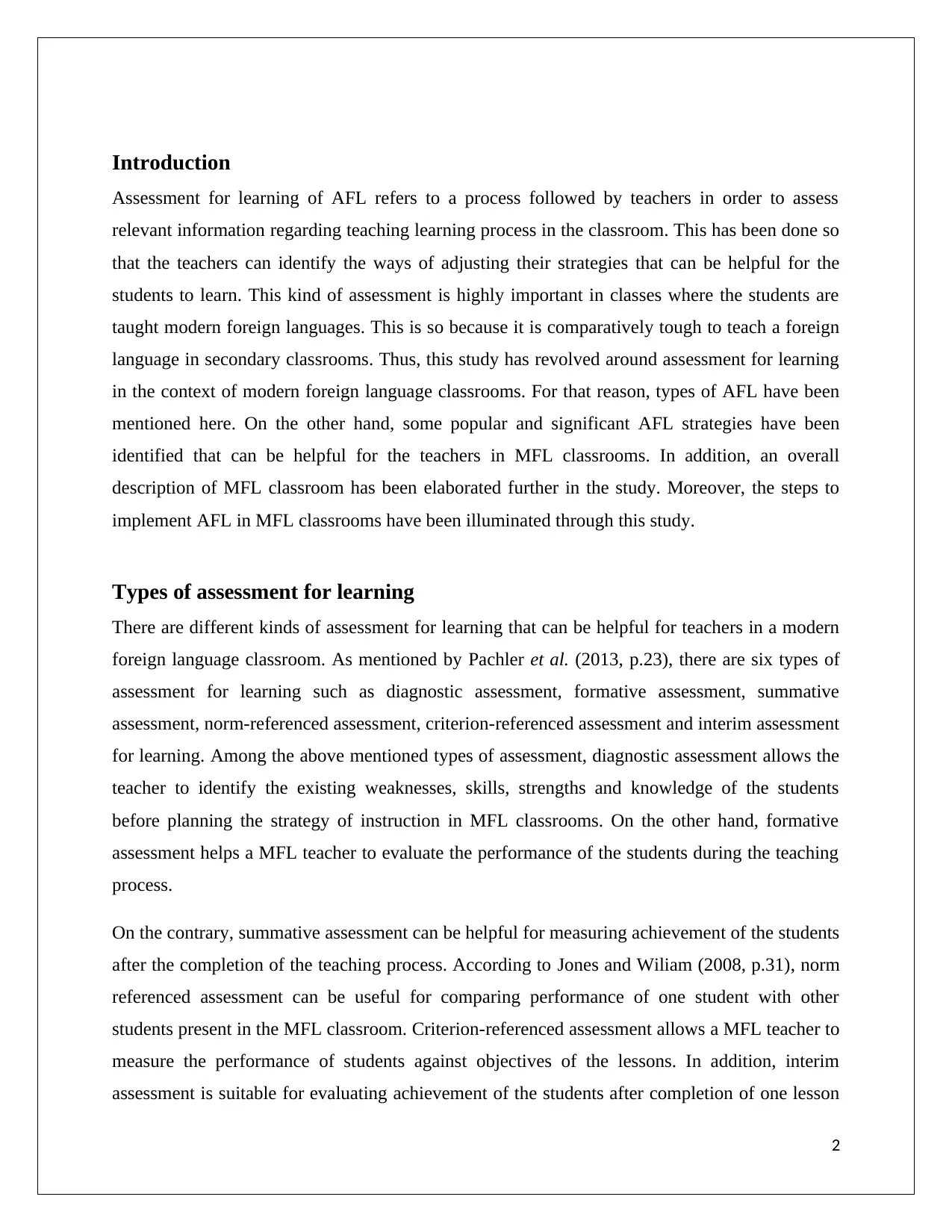
Introduction
Assessment for learning of AFL refers to a process followed by teachers in order to assess
relevant information regarding teaching learning process in the classroom. This has been done so
that the teachers can identify the ways of adjusting their strategies that can be helpful for the
students to learn. This kind of assessment is highly important in classes where the students are
taught modern foreign languages. This is so because it is comparatively tough to teach a foreign
language in secondary classrooms. Thus, this study has revolved around assessment for learning
in the context of modern foreign language classrooms. For that reason, types of AFL have been
mentioned here. On the other hand, some popular and significant AFL strategies have been
identified that can be helpful for the teachers in MFL classrooms. In addition, an overall
description of MFL classroom has been elaborated further in the study. Moreover, the steps to
implement AFL in MFL classrooms have been illuminated through this study.
Types of assessment for learning
There are different kinds of assessment for learning that can be helpful for teachers in a modern
foreign language classroom. As mentioned by Pachler et al. (2013, p.23), there are six types of
assessment for learning such as diagnostic assessment, formative assessment, summative
assessment, norm-referenced assessment, criterion-referenced assessment and interim assessment
for learning. Among the above mentioned types of assessment, diagnostic assessment allows the
teacher to identify the existing weaknesses, skills, strengths and knowledge of the students
before planning the strategy of instruction in MFL classrooms. On the other hand, formative
assessment helps a MFL teacher to evaluate the performance of the students during the teaching
process.
On the contrary, summative assessment can be helpful for measuring achievement of the students
after the completion of the teaching process. According to Jones and Wiliam (2008, p.31), norm
referenced assessment can be useful for comparing performance of one student with other
students present in the MFL classroom. Criterion-referenced assessment allows a MFL teacher to
measure the performance of students against objectives of the lessons. In addition, interim
assessment is suitable for evaluating achievement of the students after completion of one lesson
2
Assessment for learning of AFL refers to a process followed by teachers in order to assess
relevant information regarding teaching learning process in the classroom. This has been done so
that the teachers can identify the ways of adjusting their strategies that can be helpful for the
students to learn. This kind of assessment is highly important in classes where the students are
taught modern foreign languages. This is so because it is comparatively tough to teach a foreign
language in secondary classrooms. Thus, this study has revolved around assessment for learning
in the context of modern foreign language classrooms. For that reason, types of AFL have been
mentioned here. On the other hand, some popular and significant AFL strategies have been
identified that can be helpful for the teachers in MFL classrooms. In addition, an overall
description of MFL classroom has been elaborated further in the study. Moreover, the steps to
implement AFL in MFL classrooms have been illuminated through this study.
Types of assessment for learning
There are different kinds of assessment for learning that can be helpful for teachers in a modern
foreign language classroom. As mentioned by Pachler et al. (2013, p.23), there are six types of
assessment for learning such as diagnostic assessment, formative assessment, summative
assessment, norm-referenced assessment, criterion-referenced assessment and interim assessment
for learning. Among the above mentioned types of assessment, diagnostic assessment allows the
teacher to identify the existing weaknesses, skills, strengths and knowledge of the students
before planning the strategy of instruction in MFL classrooms. On the other hand, formative
assessment helps a MFL teacher to evaluate the performance of the students during the teaching
process.
On the contrary, summative assessment can be helpful for measuring achievement of the students
after the completion of the teaching process. According to Jones and Wiliam (2008, p.31), norm
referenced assessment can be useful for comparing performance of one student with other
students present in the MFL classroom. Criterion-referenced assessment allows a MFL teacher to
measure the performance of students against objectives of the lessons. In addition, interim
assessment is suitable for evaluating achievement of the students after completion of one lesson
2
⊘ This is a preview!⊘
Do you want full access?
Subscribe today to unlock all pages.

Trusted by 1+ million students worldwide
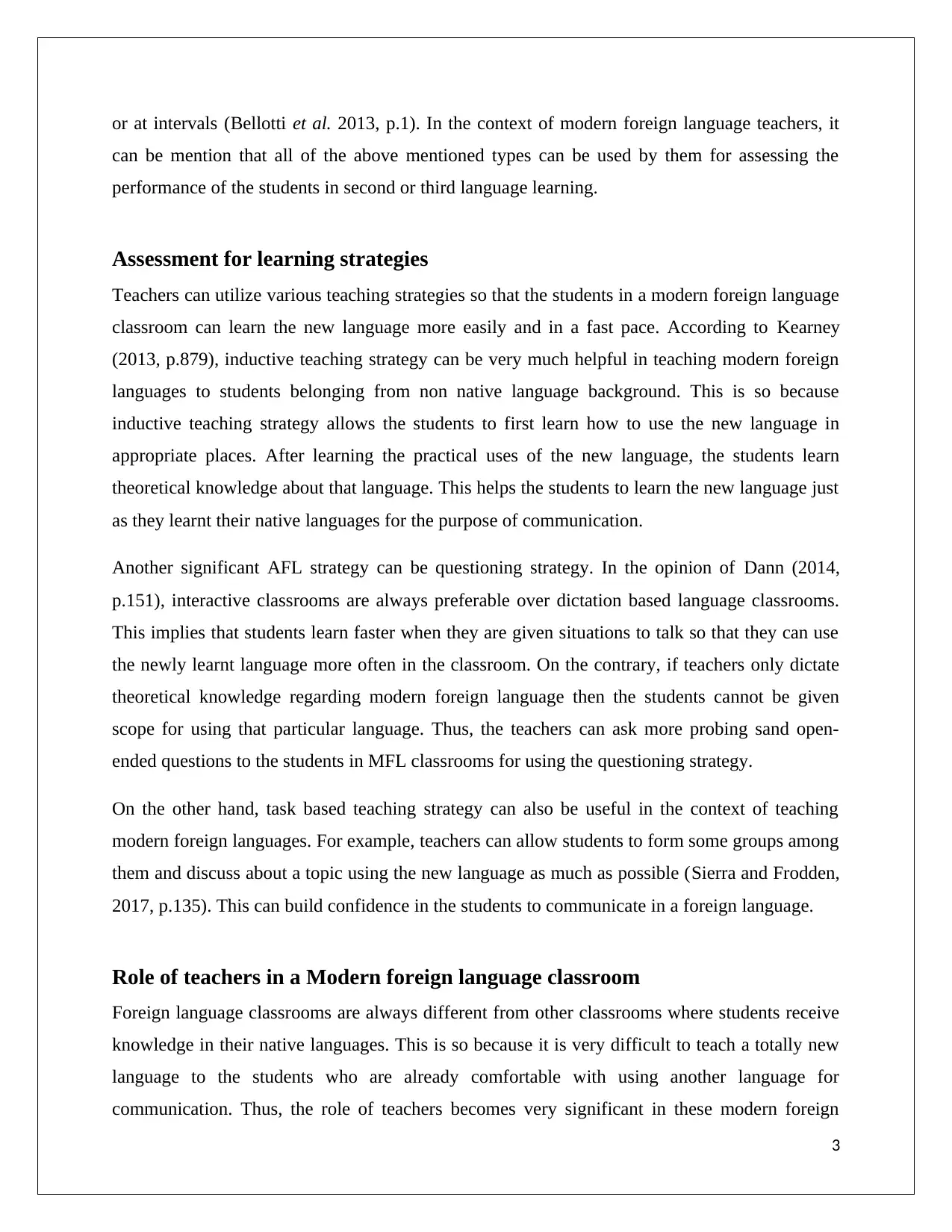
or at intervals (Bellotti et al. 2013, p.1). In the context of modern foreign language teachers, it
can be mention that all of the above mentioned types can be used by them for assessing the
performance of the students in second or third language learning.
Assessment for learning strategies
Teachers can utilize various teaching strategies so that the students in a modern foreign language
classroom can learn the new language more easily and in a fast pace. According to Kearney
(2013, p.879), inductive teaching strategy can be very much helpful in teaching modern foreign
languages to students belonging from non native language background. This is so because
inductive teaching strategy allows the students to first learn how to use the new language in
appropriate places. After learning the practical uses of the new language, the students learn
theoretical knowledge about that language. This helps the students to learn the new language just
as they learnt their native languages for the purpose of communication.
Another significant AFL strategy can be questioning strategy. In the opinion of Dann (2014,
p.151), interactive classrooms are always preferable over dictation based language classrooms.
This implies that students learn faster when they are given situations to talk so that they can use
the newly learnt language more often in the classroom. On the contrary, if teachers only dictate
theoretical knowledge regarding modern foreign language then the students cannot be given
scope for using that particular language. Thus, the teachers can ask more probing sand open-
ended questions to the students in MFL classrooms for using the questioning strategy.
On the other hand, task based teaching strategy can also be useful in the context of teaching
modern foreign languages. For example, teachers can allow students to form some groups among
them and discuss about a topic using the new language as much as possible (Sierra and Frodden,
2017, p.135). This can build confidence in the students to communicate in a foreign language.
Role of teachers in a Modern foreign language classroom
Foreign language classrooms are always different from other classrooms where students receive
knowledge in their native languages. This is so because it is very difficult to teach a totally new
language to the students who are already comfortable with using another language for
communication. Thus, the role of teachers becomes very significant in these modern foreign
3
can be mention that all of the above mentioned types can be used by them for assessing the
performance of the students in second or third language learning.
Assessment for learning strategies
Teachers can utilize various teaching strategies so that the students in a modern foreign language
classroom can learn the new language more easily and in a fast pace. According to Kearney
(2013, p.879), inductive teaching strategy can be very much helpful in teaching modern foreign
languages to students belonging from non native language background. This is so because
inductive teaching strategy allows the students to first learn how to use the new language in
appropriate places. After learning the practical uses of the new language, the students learn
theoretical knowledge about that language. This helps the students to learn the new language just
as they learnt their native languages for the purpose of communication.
Another significant AFL strategy can be questioning strategy. In the opinion of Dann (2014,
p.151), interactive classrooms are always preferable over dictation based language classrooms.
This implies that students learn faster when they are given situations to talk so that they can use
the newly learnt language more often in the classroom. On the contrary, if teachers only dictate
theoretical knowledge regarding modern foreign language then the students cannot be given
scope for using that particular language. Thus, the teachers can ask more probing sand open-
ended questions to the students in MFL classrooms for using the questioning strategy.
On the other hand, task based teaching strategy can also be useful in the context of teaching
modern foreign languages. For example, teachers can allow students to form some groups among
them and discuss about a topic using the new language as much as possible (Sierra and Frodden,
2017, p.135). This can build confidence in the students to communicate in a foreign language.
Role of teachers in a Modern foreign language classroom
Foreign language classrooms are always different from other classrooms where students receive
knowledge in their native languages. This is so because it is very difficult to teach a totally new
language to the students who are already comfortable with using another language for
communication. Thus, the role of teachers becomes very significant in these modern foreign
3
Paraphrase This Document
Need a fresh take? Get an instant paraphrase of this document with our AI Paraphraser
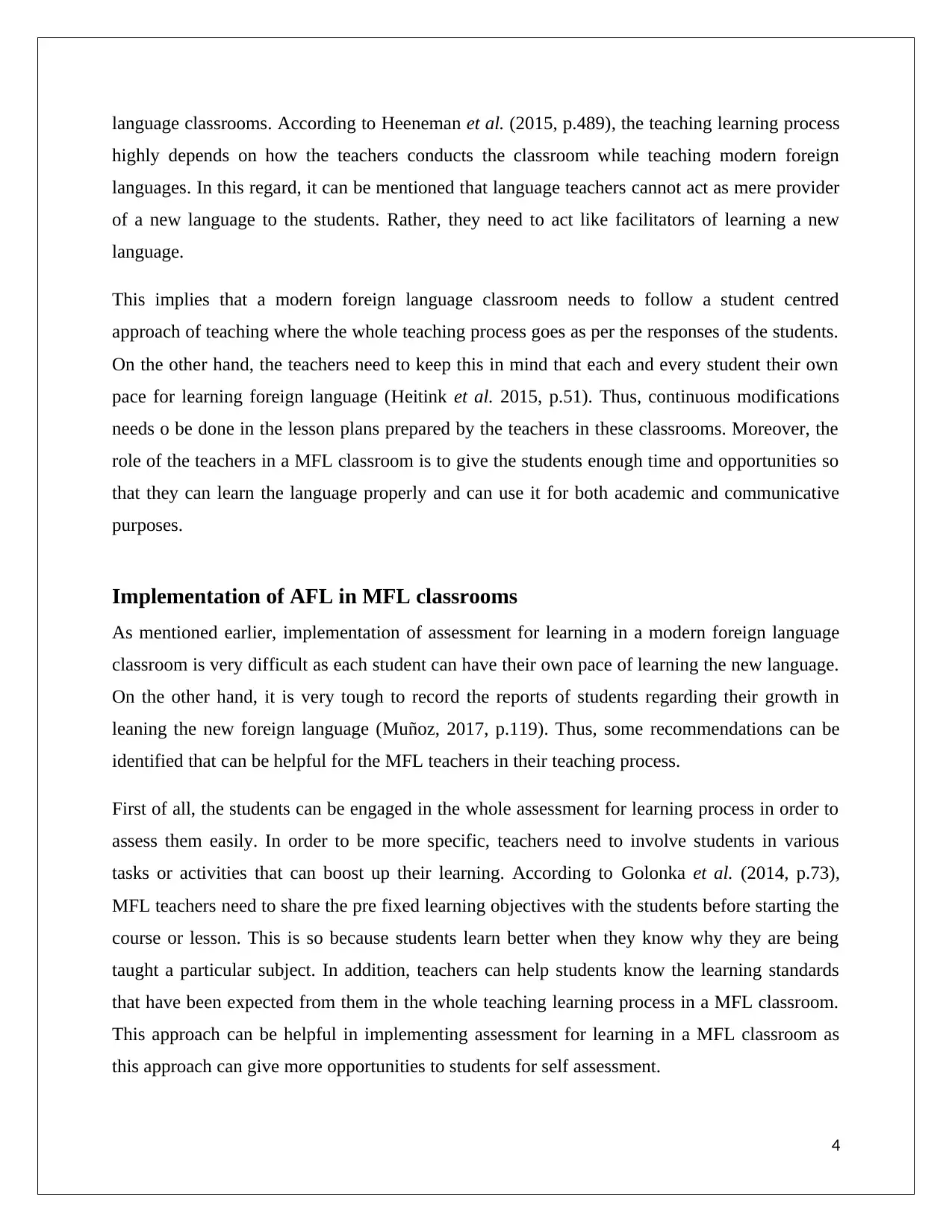
language classrooms. According to Heeneman et al. (2015, p.489), the teaching learning process
highly depends on how the teachers conducts the classroom while teaching modern foreign
languages. In this regard, it can be mentioned that language teachers cannot act as mere provider
of a new language to the students. Rather, they need to act like facilitators of learning a new
language.
This implies that a modern foreign language classroom needs to follow a student centred
approach of teaching where the whole teaching process goes as per the responses of the students.
On the other hand, the teachers need to keep this in mind that each and every student their own
pace for learning foreign language (Heitink et al. 2015, p.51). Thus, continuous modifications
needs o be done in the lesson plans prepared by the teachers in these classrooms. Moreover, the
role of the teachers in a MFL classroom is to give the students enough time and opportunities so
that they can learn the language properly and can use it for both academic and communicative
purposes.
Implementation of AFL in MFL classrooms
As mentioned earlier, implementation of assessment for learning in a modern foreign language
classroom is very difficult as each student can have their own pace of learning the new language.
On the other hand, it is very tough to record the reports of students regarding their growth in
leaning the new foreign language (Muñoz, 2017, p.119). Thus, some recommendations can be
identified that can be helpful for the MFL teachers in their teaching process.
First of all, the students can be engaged in the whole assessment for learning process in order to
assess them easily. In order to be more specific, teachers need to involve students in various
tasks or activities that can boost up their learning. According to Golonka et al. (2014, p.73),
MFL teachers need to share the pre fixed learning objectives with the students before starting the
course or lesson. This is so because students learn better when they know why they are being
taught a particular subject. In addition, teachers can help students know the learning standards
that have been expected from them in the whole teaching learning process in a MFL classroom.
This approach can be helpful in implementing assessment for learning in a MFL classroom as
this approach can give more opportunities to students for self assessment.
4
highly depends on how the teachers conducts the classroom while teaching modern foreign
languages. In this regard, it can be mentioned that language teachers cannot act as mere provider
of a new language to the students. Rather, they need to act like facilitators of learning a new
language.
This implies that a modern foreign language classroom needs to follow a student centred
approach of teaching where the whole teaching process goes as per the responses of the students.
On the other hand, the teachers need to keep this in mind that each and every student their own
pace for learning foreign language (Heitink et al. 2015, p.51). Thus, continuous modifications
needs o be done in the lesson plans prepared by the teachers in these classrooms. Moreover, the
role of the teachers in a MFL classroom is to give the students enough time and opportunities so
that they can learn the language properly and can use it for both academic and communicative
purposes.
Implementation of AFL in MFL classrooms
As mentioned earlier, implementation of assessment for learning in a modern foreign language
classroom is very difficult as each student can have their own pace of learning the new language.
On the other hand, it is very tough to record the reports of students regarding their growth in
leaning the new foreign language (Muñoz, 2017, p.119). Thus, some recommendations can be
identified that can be helpful for the MFL teachers in their teaching process.
First of all, the students can be engaged in the whole assessment for learning process in order to
assess them easily. In order to be more specific, teachers need to involve students in various
tasks or activities that can boost up their learning. According to Golonka et al. (2014, p.73),
MFL teachers need to share the pre fixed learning objectives with the students before starting the
course or lesson. This is so because students learn better when they know why they are being
taught a particular subject. In addition, teachers can help students know the learning standards
that have been expected from them in the whole teaching learning process in a MFL classroom.
This approach can be helpful in implementing assessment for learning in a MFL classroom as
this approach can give more opportunities to students for self assessment.
4
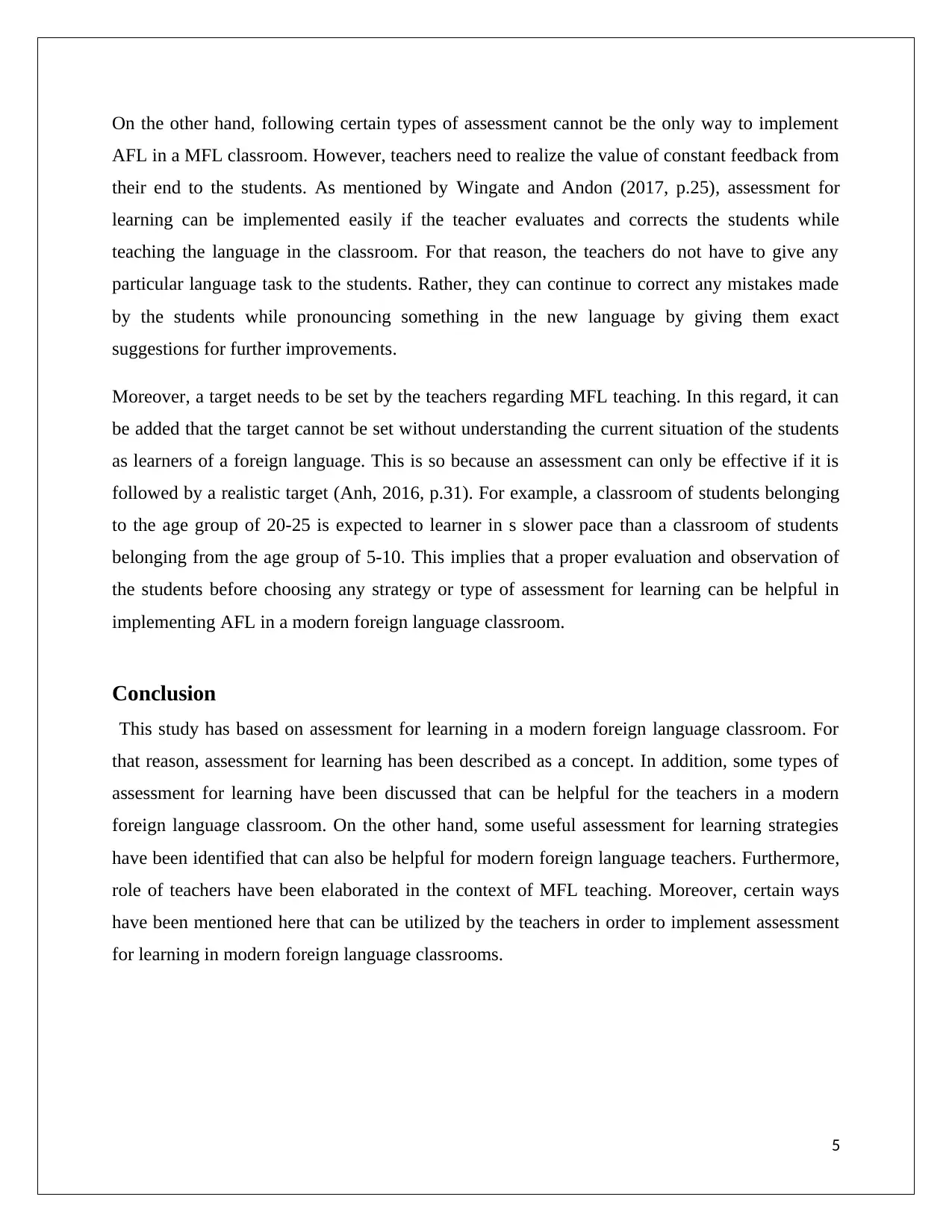
On the other hand, following certain types of assessment cannot be the only way to implement
AFL in a MFL classroom. However, teachers need to realize the value of constant feedback from
their end to the students. As mentioned by Wingate and Andon (2017, p.25), assessment for
learning can be implemented easily if the teacher evaluates and corrects the students while
teaching the language in the classroom. For that reason, the teachers do not have to give any
particular language task to the students. Rather, they can continue to correct any mistakes made
by the students while pronouncing something in the new language by giving them exact
suggestions for further improvements.
Moreover, a target needs to be set by the teachers regarding MFL teaching. In this regard, it can
be added that the target cannot be set without understanding the current situation of the students
as learners of a foreign language. This is so because an assessment can only be effective if it is
followed by a realistic target (Anh, 2016, p.31). For example, a classroom of students belonging
to the age group of 20-25 is expected to learner in s slower pace than a classroom of students
belonging from the age group of 5-10. This implies that a proper evaluation and observation of
the students before choosing any strategy or type of assessment for learning can be helpful in
implementing AFL in a modern foreign language classroom.
Conclusion
This study has based on assessment for learning in a modern foreign language classroom. For
that reason, assessment for learning has been described as a concept. In addition, some types of
assessment for learning have been discussed that can be helpful for the teachers in a modern
foreign language classroom. On the other hand, some useful assessment for learning strategies
have been identified that can also be helpful for modern foreign language teachers. Furthermore,
role of teachers have been elaborated in the context of MFL teaching. Moreover, certain ways
have been mentioned here that can be utilized by the teachers in order to implement assessment
for learning in modern foreign language classrooms.
5
AFL in a MFL classroom. However, teachers need to realize the value of constant feedback from
their end to the students. As mentioned by Wingate and Andon (2017, p.25), assessment for
learning can be implemented easily if the teacher evaluates and corrects the students while
teaching the language in the classroom. For that reason, the teachers do not have to give any
particular language task to the students. Rather, they can continue to correct any mistakes made
by the students while pronouncing something in the new language by giving them exact
suggestions for further improvements.
Moreover, a target needs to be set by the teachers regarding MFL teaching. In this regard, it can
be added that the target cannot be set without understanding the current situation of the students
as learners of a foreign language. This is so because an assessment can only be effective if it is
followed by a realistic target (Anh, 2016, p.31). For example, a classroom of students belonging
to the age group of 20-25 is expected to learner in s slower pace than a classroom of students
belonging from the age group of 5-10. This implies that a proper evaluation and observation of
the students before choosing any strategy or type of assessment for learning can be helpful in
implementing AFL in a modern foreign language classroom.
Conclusion
This study has based on assessment for learning in a modern foreign language classroom. For
that reason, assessment for learning has been described as a concept. In addition, some types of
assessment for learning have been discussed that can be helpful for the teachers in a modern
foreign language classroom. On the other hand, some useful assessment for learning strategies
have been identified that can also be helpful for modern foreign language teachers. Furthermore,
role of teachers have been elaborated in the context of MFL teaching. Moreover, certain ways
have been mentioned here that can be utilized by the teachers in order to implement assessment
for learning in modern foreign language classrooms.
5
⊘ This is a preview!⊘
Do you want full access?
Subscribe today to unlock all pages.

Trusted by 1+ million students worldwide
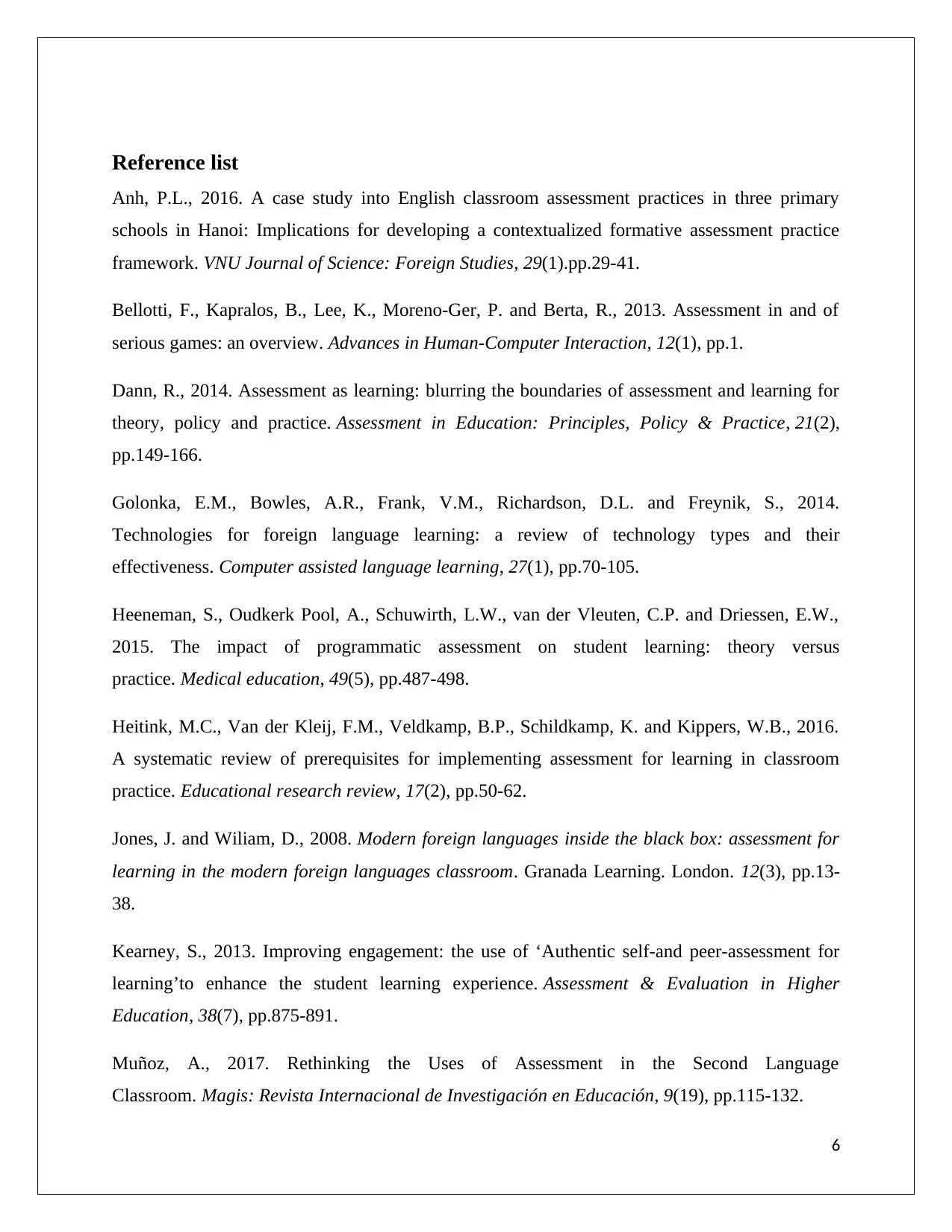
Reference list
Anh, P.L., 2016. A case study into English classroom assessment practices in three primary
schools in Hanoi: Implications for developing a contextualized formative assessment practice
framework. VNU Journal of Science: Foreign Studies, 29(1).pp.29-41.
Bellotti, F., Kapralos, B., Lee, K., Moreno-Ger, P. and Berta, R., 2013. Assessment in and of
serious games: an overview. Advances in Human-Computer Interaction, 12(1), pp.1.
Dann, R., 2014. Assessment as learning: blurring the boundaries of assessment and learning for
theory, policy and practice. Assessment in Education: Principles, Policy & Practice, 21(2),
pp.149-166.
Golonka, E.M., Bowles, A.R., Frank, V.M., Richardson, D.L. and Freynik, S., 2014.
Technologies for foreign language learning: a review of technology types and their
effectiveness. Computer assisted language learning, 27(1), pp.70-105.
Heeneman, S., Oudkerk Pool, A., Schuwirth, L.W., van der Vleuten, C.P. and Driessen, E.W.,
2015. The impact of programmatic assessment on student learning: theory versus
practice. Medical education, 49(5), pp.487-498.
Heitink, M.C., Van der Kleij, F.M., Veldkamp, B.P., Schildkamp, K. and Kippers, W.B., 2016.
A systematic review of prerequisites for implementing assessment for learning in classroom
practice. Educational research review, 17(2), pp.50-62.
Jones, J. and Wiliam, D., 2008. Modern foreign languages inside the black box: assessment for
learning in the modern foreign languages classroom. Granada Learning. London. 12(3), pp.13-
38.
Kearney, S., 2013. Improving engagement: the use of ‘Authentic self-and peer-assessment for
learning’to enhance the student learning experience. Assessment & Evaluation in Higher
Education, 38(7), pp.875-891.
Muñoz, A., 2017. Rethinking the Uses of Assessment in the Second Language
Classroom. Magis: Revista Internacional de Investigación en Educación, 9(19), pp.115-132.
6
Anh, P.L., 2016. A case study into English classroom assessment practices in three primary
schools in Hanoi: Implications for developing a contextualized formative assessment practice
framework. VNU Journal of Science: Foreign Studies, 29(1).pp.29-41.
Bellotti, F., Kapralos, B., Lee, K., Moreno-Ger, P. and Berta, R., 2013. Assessment in and of
serious games: an overview. Advances in Human-Computer Interaction, 12(1), pp.1.
Dann, R., 2014. Assessment as learning: blurring the boundaries of assessment and learning for
theory, policy and practice. Assessment in Education: Principles, Policy & Practice, 21(2),
pp.149-166.
Golonka, E.M., Bowles, A.R., Frank, V.M., Richardson, D.L. and Freynik, S., 2014.
Technologies for foreign language learning: a review of technology types and their
effectiveness. Computer assisted language learning, 27(1), pp.70-105.
Heeneman, S., Oudkerk Pool, A., Schuwirth, L.W., van der Vleuten, C.P. and Driessen, E.W.,
2015. The impact of programmatic assessment on student learning: theory versus
practice. Medical education, 49(5), pp.487-498.
Heitink, M.C., Van der Kleij, F.M., Veldkamp, B.P., Schildkamp, K. and Kippers, W.B., 2016.
A systematic review of prerequisites for implementing assessment for learning in classroom
practice. Educational research review, 17(2), pp.50-62.
Jones, J. and Wiliam, D., 2008. Modern foreign languages inside the black box: assessment for
learning in the modern foreign languages classroom. Granada Learning. London. 12(3), pp.13-
38.
Kearney, S., 2013. Improving engagement: the use of ‘Authentic self-and peer-assessment for
learning’to enhance the student learning experience. Assessment & Evaluation in Higher
Education, 38(7), pp.875-891.
Muñoz, A., 2017. Rethinking the Uses of Assessment in the Second Language
Classroom. Magis: Revista Internacional de Investigación en Educación, 9(19), pp.115-132.
6
Paraphrase This Document
Need a fresh take? Get an instant paraphrase of this document with our AI Paraphraser
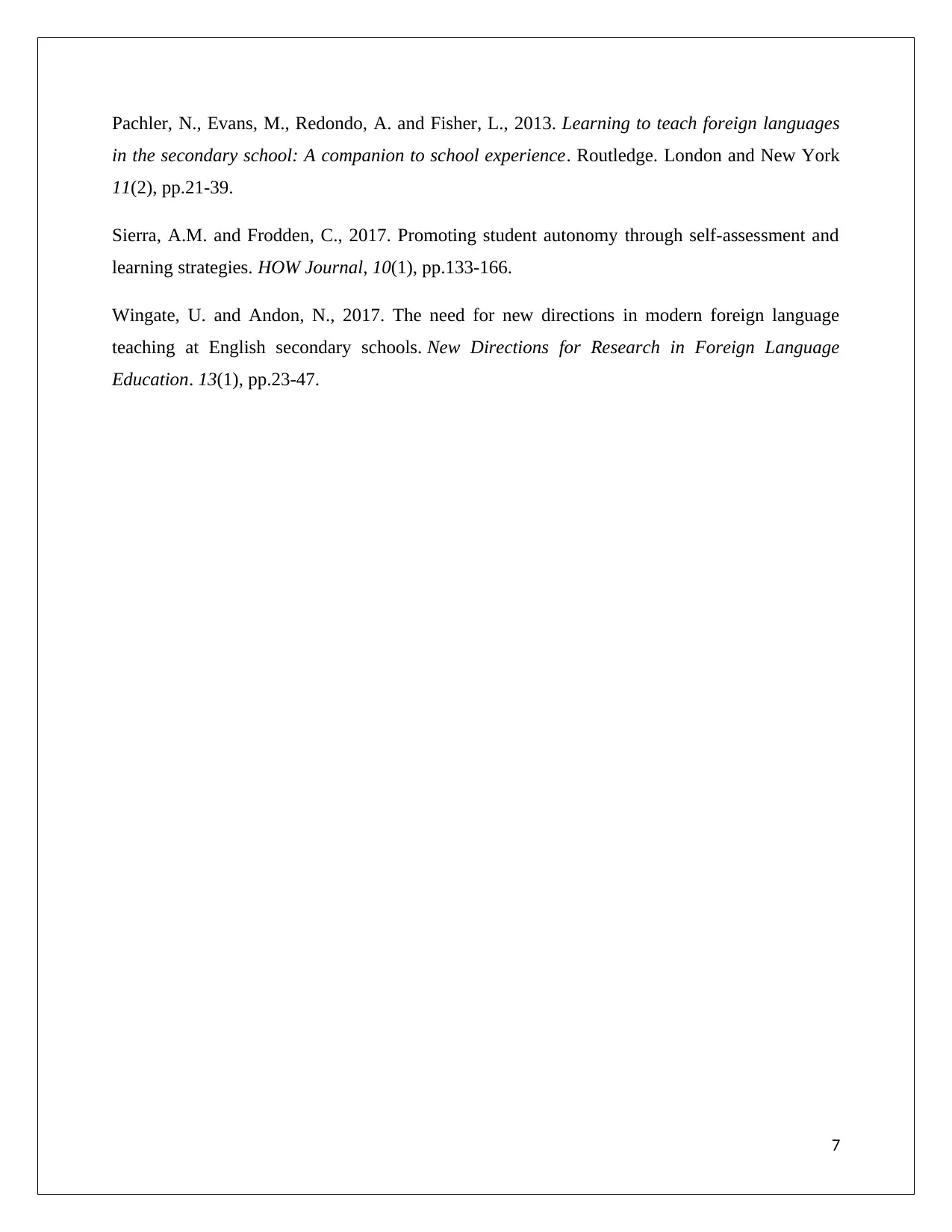
Pachler, N., Evans, M., Redondo, A. and Fisher, L., 2013. Learning to teach foreign languages
in the secondary school: A companion to school experience. Routledge. London and New York
11(2), pp.21-39.
Sierra, A.M. and Frodden, C., 2017. Promoting student autonomy through self-assessment and
learning strategies. HOW Journal, 10(1), pp.133-166.
Wingate, U. and Andon, N., 2017. The need for new directions in modern foreign language
teaching at English secondary schools. New Directions for Research in Foreign Language
Education. 13(1), pp.23-47.
7
in the secondary school: A companion to school experience. Routledge. London and New York
11(2), pp.21-39.
Sierra, A.M. and Frodden, C., 2017. Promoting student autonomy through self-assessment and
learning strategies. HOW Journal, 10(1), pp.133-166.
Wingate, U. and Andon, N., 2017. The need for new directions in modern foreign language
teaching at English secondary schools. New Directions for Research in Foreign Language
Education. 13(1), pp.23-47.
7
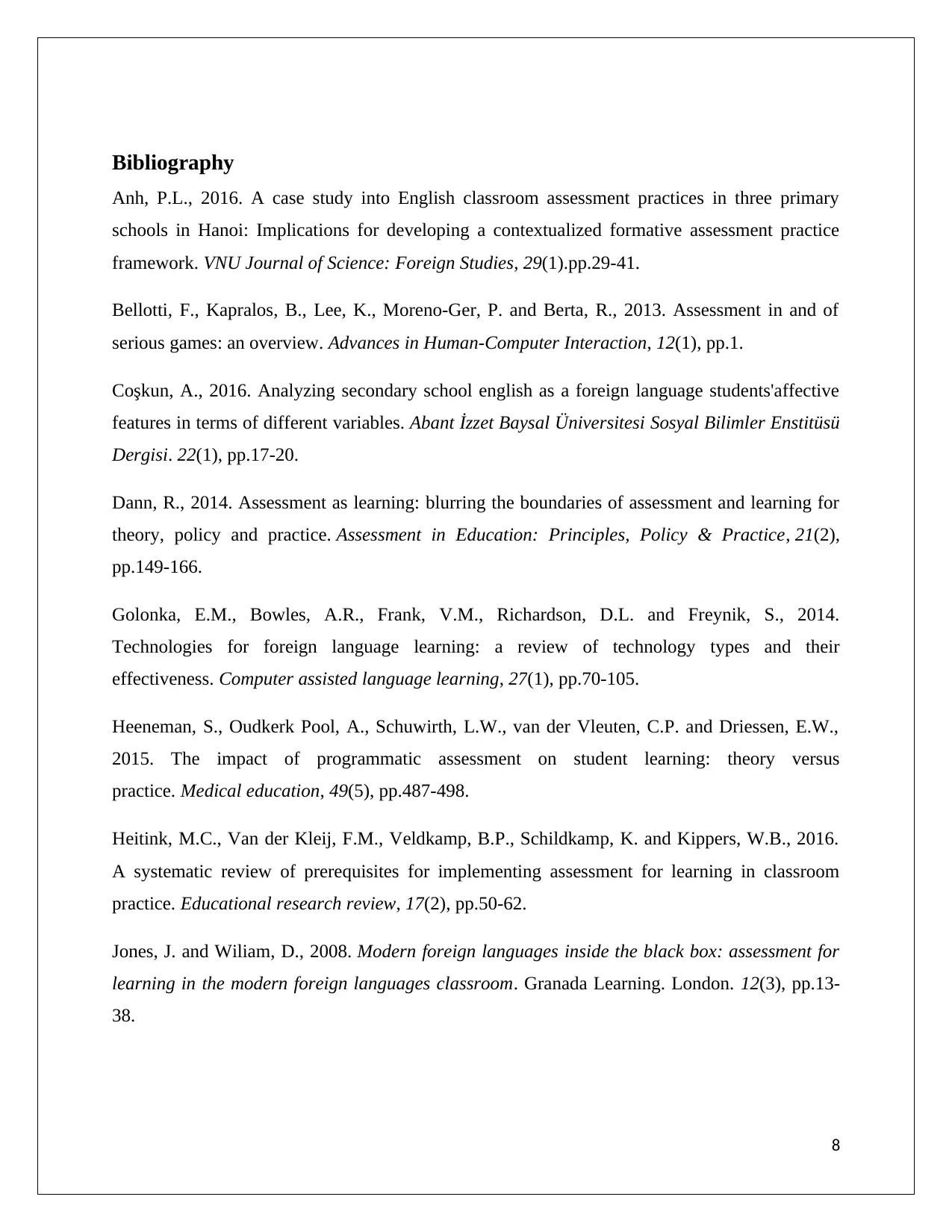
Bibliography
Anh, P.L., 2016. A case study into English classroom assessment practices in three primary
schools in Hanoi: Implications for developing a contextualized formative assessment practice
framework. VNU Journal of Science: Foreign Studies, 29(1).pp.29-41.
Bellotti, F., Kapralos, B., Lee, K., Moreno-Ger, P. and Berta, R., 2013. Assessment in and of
serious games: an overview. Advances in Human-Computer Interaction, 12(1), pp.1.
Coşkun, A., 2016. Analyzing secondary school english as a foreign language students'affective
features in terms of different variables. Abant İzzet Baysal Üniversitesi Sosyal Bilimler Enstitüsü
Dergisi. 22(1), pp.17-20.
Dann, R., 2014. Assessment as learning: blurring the boundaries of assessment and learning for
theory, policy and practice. Assessment in Education: Principles, Policy & Practice, 21(2),
pp.149-166.
Golonka, E.M., Bowles, A.R., Frank, V.M., Richardson, D.L. and Freynik, S., 2014.
Technologies for foreign language learning: a review of technology types and their
effectiveness. Computer assisted language learning, 27(1), pp.70-105.
Heeneman, S., Oudkerk Pool, A., Schuwirth, L.W., van der Vleuten, C.P. and Driessen, E.W.,
2015. The impact of programmatic assessment on student learning: theory versus
practice. Medical education, 49(5), pp.487-498.
Heitink, M.C., Van der Kleij, F.M., Veldkamp, B.P., Schildkamp, K. and Kippers, W.B., 2016.
A systematic review of prerequisites for implementing assessment for learning in classroom
practice. Educational research review, 17(2), pp.50-62.
Jones, J. and Wiliam, D., 2008. Modern foreign languages inside the black box: assessment for
learning in the modern foreign languages classroom. Granada Learning. London. 12(3), pp.13-
38.
8
Anh, P.L., 2016. A case study into English classroom assessment practices in three primary
schools in Hanoi: Implications for developing a contextualized formative assessment practice
framework. VNU Journal of Science: Foreign Studies, 29(1).pp.29-41.
Bellotti, F., Kapralos, B., Lee, K., Moreno-Ger, P. and Berta, R., 2013. Assessment in and of
serious games: an overview. Advances in Human-Computer Interaction, 12(1), pp.1.
Coşkun, A., 2016. Analyzing secondary school english as a foreign language students'affective
features in terms of different variables. Abant İzzet Baysal Üniversitesi Sosyal Bilimler Enstitüsü
Dergisi. 22(1), pp.17-20.
Dann, R., 2014. Assessment as learning: blurring the boundaries of assessment and learning for
theory, policy and practice. Assessment in Education: Principles, Policy & Practice, 21(2),
pp.149-166.
Golonka, E.M., Bowles, A.R., Frank, V.M., Richardson, D.L. and Freynik, S., 2014.
Technologies for foreign language learning: a review of technology types and their
effectiveness. Computer assisted language learning, 27(1), pp.70-105.
Heeneman, S., Oudkerk Pool, A., Schuwirth, L.W., van der Vleuten, C.P. and Driessen, E.W.,
2015. The impact of programmatic assessment on student learning: theory versus
practice. Medical education, 49(5), pp.487-498.
Heitink, M.C., Van der Kleij, F.M., Veldkamp, B.P., Schildkamp, K. and Kippers, W.B., 2016.
A systematic review of prerequisites for implementing assessment for learning in classroom
practice. Educational research review, 17(2), pp.50-62.
Jones, J. and Wiliam, D., 2008. Modern foreign languages inside the black box: assessment for
learning in the modern foreign languages classroom. Granada Learning. London. 12(3), pp.13-
38.
8
⊘ This is a preview!⊘
Do you want full access?
Subscribe today to unlock all pages.

Trusted by 1+ million students worldwide
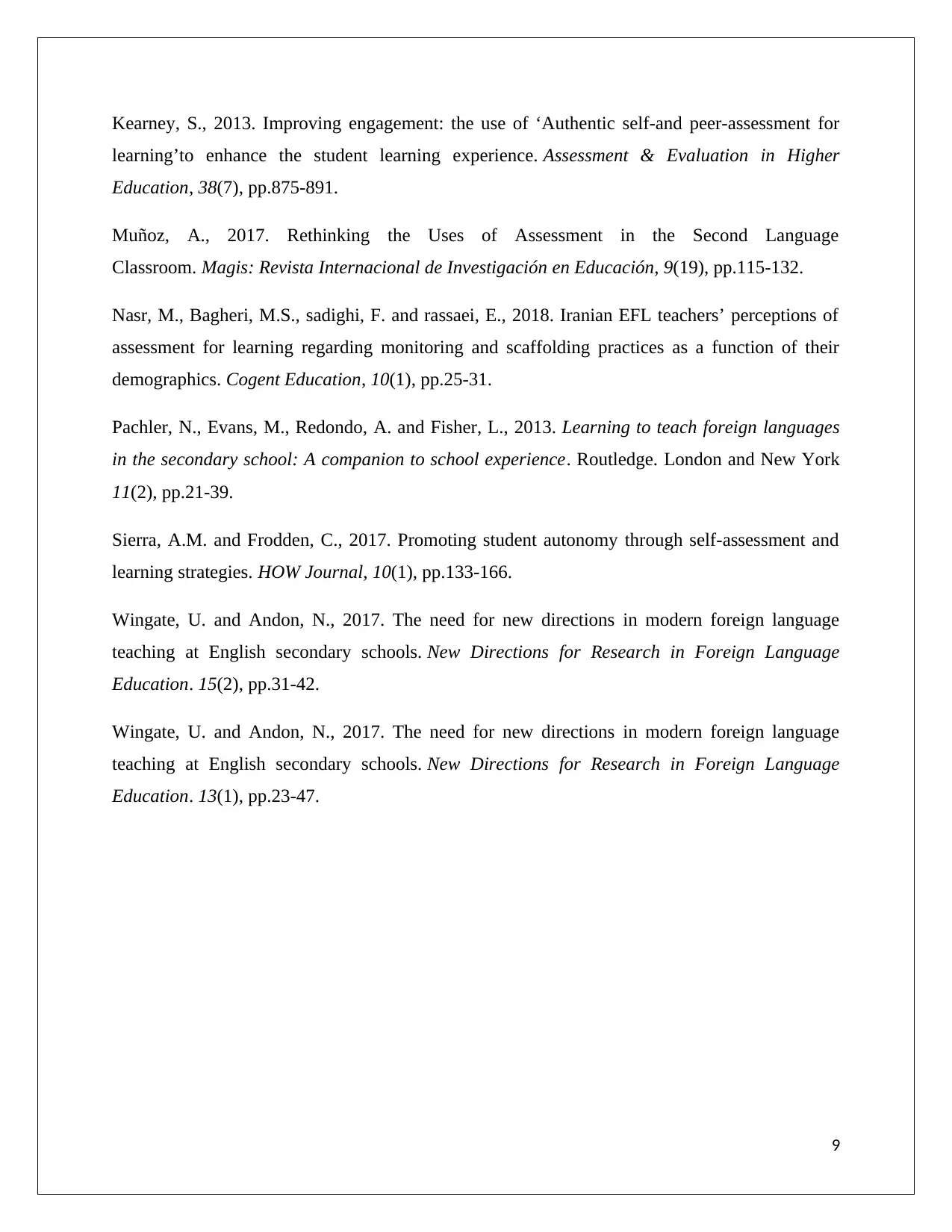
Kearney, S., 2013. Improving engagement: the use of ‘Authentic self-and peer-assessment for
learning’to enhance the student learning experience. Assessment & Evaluation in Higher
Education, 38(7), pp.875-891.
Muñoz, A., 2017. Rethinking the Uses of Assessment in the Second Language
Classroom. Magis: Revista Internacional de Investigación en Educación, 9(19), pp.115-132.
Nasr, M., Bagheri, M.S., sadighi, F. and rassaei, E., 2018. Iranian EFL teachers’ perceptions of
assessment for learning regarding monitoring and scaffolding practices as a function of their
demographics. Cogent Education, 10(1), pp.25-31.
Pachler, N., Evans, M., Redondo, A. and Fisher, L., 2013. Learning to teach foreign languages
in the secondary school: A companion to school experience. Routledge. London and New York
11(2), pp.21-39.
Sierra, A.M. and Frodden, C., 2017. Promoting student autonomy through self-assessment and
learning strategies. HOW Journal, 10(1), pp.133-166.
Wingate, U. and Andon, N., 2017. The need for new directions in modern foreign language
teaching at English secondary schools. New Directions for Research in Foreign Language
Education. 15(2), pp.31-42.
Wingate, U. and Andon, N., 2017. The need for new directions in modern foreign language
teaching at English secondary schools. New Directions for Research in Foreign Language
Education. 13(1), pp.23-47.
9
learning’to enhance the student learning experience. Assessment & Evaluation in Higher
Education, 38(7), pp.875-891.
Muñoz, A., 2017. Rethinking the Uses of Assessment in the Second Language
Classroom. Magis: Revista Internacional de Investigación en Educación, 9(19), pp.115-132.
Nasr, M., Bagheri, M.S., sadighi, F. and rassaei, E., 2018. Iranian EFL teachers’ perceptions of
assessment for learning regarding monitoring and scaffolding practices as a function of their
demographics. Cogent Education, 10(1), pp.25-31.
Pachler, N., Evans, M., Redondo, A. and Fisher, L., 2013. Learning to teach foreign languages
in the secondary school: A companion to school experience. Routledge. London and New York
11(2), pp.21-39.
Sierra, A.M. and Frodden, C., 2017. Promoting student autonomy through self-assessment and
learning strategies. HOW Journal, 10(1), pp.133-166.
Wingate, U. and Andon, N., 2017. The need for new directions in modern foreign language
teaching at English secondary schools. New Directions for Research in Foreign Language
Education. 15(2), pp.31-42.
Wingate, U. and Andon, N., 2017. The need for new directions in modern foreign language
teaching at English secondary schools. New Directions for Research in Foreign Language
Education. 13(1), pp.23-47.
9
1 out of 10
Related Documents
Your All-in-One AI-Powered Toolkit for Academic Success.
+13062052269
info@desklib.com
Available 24*7 on WhatsApp / Email
![[object Object]](/_next/static/media/star-bottom.7253800d.svg)
Unlock your academic potential
Copyright © 2020–2025 A2Z Services. All Rights Reserved. Developed and managed by ZUCOL.





